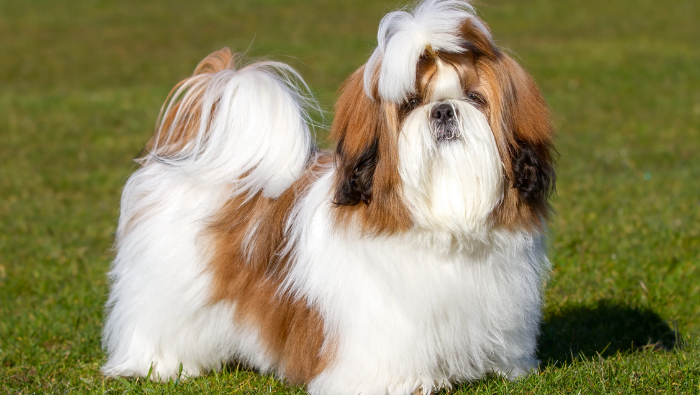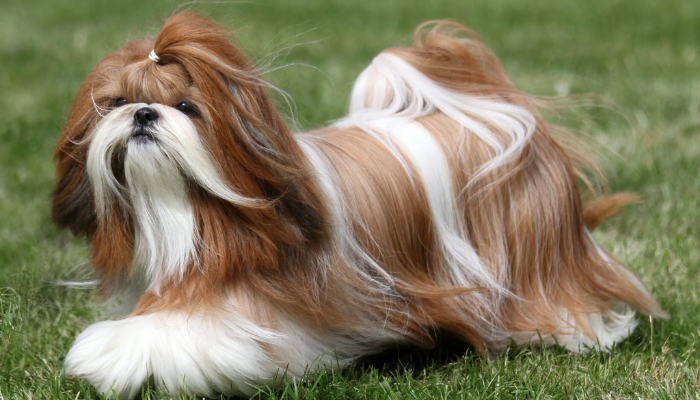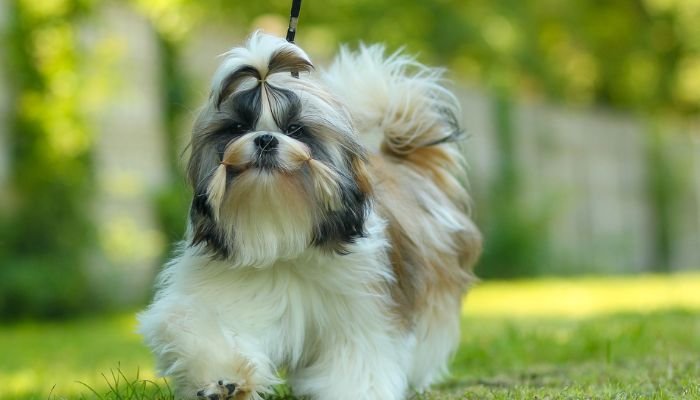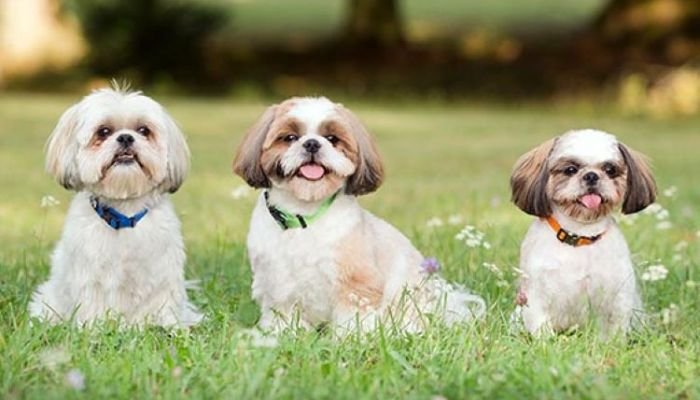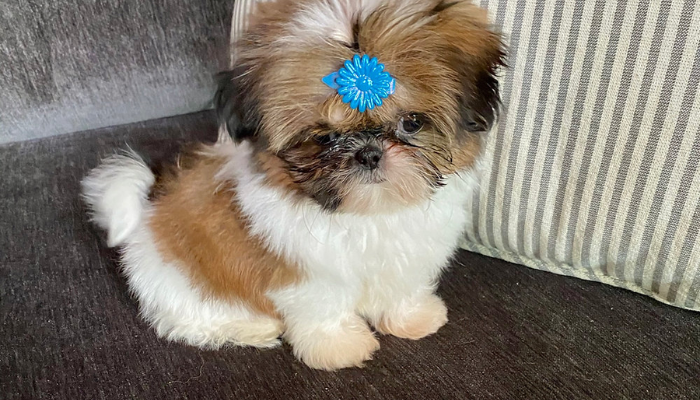The Shih Tzu is a tiny dog from Tibet, purportedly bred from the now-extinct Pekingese and Lhasa Apso, ages ago. While its name means “Little Lion,” there is nothing fierce about this breed. Friendly and efficient, Shih Tzus have earned their place in the laps of people of all classes since ancient years. Known to sow joy and elation in life, the cute little pet stands for cute and tiny!
Active and friendly in temperament, Shih Tzu is a heavy breed, regulated in physical size, between 7 Kg and an average height of 10 inches. The Shih Tzu dog has long, silky hair; a flat snout; very overgrown teeth; and ears that are short, downward hanging, and floppy. The Shih Tzu’s head is round and its eyes are very big and expressive. If you are thinking of adopting this cute dog breed then go through this blog to explore more about Shih Tzu.

Shih Tzu Dog Breed Height
Male: 7.9–11.0 in
Female: 7.9–11.0 in

Shih Tzu Dog Breed Weight
Male: 6- 7 kg
Female: 5- 6 kg

Shih Tzu Dog Breed
Lifespan
10 to 18 years
| Build | Compact and sturdy with a solid frame |
| Coat | Knowing for its long and flowing double-coat |
| Color | Black, white, gold |
| Ears | Ears are lower down and too small |
| Eyes | Large eyes and round with brown color |
| Muzzle | The muzzle is short and the board |
| Tail | The tails are set high, curled, and over the back |
| Movement | Smooth and Energetic Movement |
| Food | Mostly Veg and sometimes Non- Veg |
| Worked as | Playful dog and friendly with lots of affection |
Shih Tzu Dog Breed Traits, Personality & Characteristics
Cute and friendly-natured, these pets exist in an environment where they’re treated like human children. The dogs are suitable for experienced owners who can provide structured training, regular exercise, and socialization. With proper training, these canines are amongst the cutest playmates either at home or at the dog park. Let us have a detailed knowledge of the temperament and character of Shih Tzu.
- Family
- Social
- Physical
- Personality
Also Read: German Shepherd Rottweiler Mix Traits & Personality | German Shepherd Golden Retriever Mix Traits & Personality
Shih Tzu Dog Breed Temperaments
The Shih Tzu’s history has played a very critical role in fashioning their temperaments today. Bred purely for companionship, they often have separation anxiety and attention-seeking behaviors when not socialized properly, to a great deal or extent.
Yet another common behavior problem in Shih Tzus that parents often encounter is that they may be touch-sensitive. The characteristic of this small breed is the long overflowing coat. Being small, yet a lot of grooming is required of them, they are often approached without consent for handling, such as picking them up from the ground to pet the face or grooming around the ears. This practice has generally rendered many Shih Tzus shy of hands or touch.
Also Read: German Shepherd Rottweiler Mix Temperament | German Shepherd Golden Retriever Mix Temperament
Shih Tzu Dog With Children and Other Pets
They are good for kids, of course, but few breeds can truly be called “child-friendly.” They can be gentle dogs that know when to be soft and gentle, yet are always up for some adventure or romp in the yard. Gentle enough and sociable enough, it is not uncommon to see Shih Tzus working as therapy dogs.
Boundaries, respect, and proper handling of the dog should all be thoroughly taught to your kids before bringing the dog home. You must not ever leave small children unattended with your Shih Tzu. It’s a recipe for disaster for both your pet and your kids to try and leave them alone with one another because it honestly sets either up for injury in case roughhousing happens or any type of squabbling ensues.
Shih Tzus are usually very good with other pets, and because of their friendly and sociable nature, they usually get along with other dogs, old or young, cats, and even small animals if introduced and socialized properly. However, each playtime is filled with excitement, so it requires parental supervision of these encounters to ensure that everyone plays nicely and feels comfortable.
History of the Shih Tzu Dog Breed
Attempts to trace the exact origin of the Shih Tzu seem to produce blurred results. It is contended that they moonlighted as little lion-type dogs for Tibetan ministers, later passing into the cold arms of the Chinese rulers. Much of their being-like-a-small “Little Lion” likely has this kind of Buddhism in mind, which asserts that a lion represents power and protection.
These dogs were initially companion animals and played a common role in embodying Buddhist values. They served as guardians in the royal palaces through alertness. The Shih Tzu’s fame greatly rose during the Ming Dynasty of China, where it was bred as an imperial companion breed. These dogs were adored by the emperors and empresses for their beauty, loyalty, and affectionate personalities.
Also Read: History of The Labrador Retriever | History Belongs to Border Collie
Shih Tzu Dog Food Diet & Feeding Pattern
Feed your dog high-protein dry food during the day to keep her full, as it is the recommended type of food for Shih Tzus. Good pet foods for Shih Tzus are generally made from lean meat, such as salmon, beef, lamb, chicken, and even pork liver, to supplement lean muscle and support maintaining pet weight. Shih Tzus can also greatly benefit from a regular omega fatty acids 3 and 6 intake.
Shih Tzu Dog Feeding Patterns:
- Puppies (0-1 years): 1.0-2.0 oz per day
- Adults (1-9 years): 2.0-3.4 oz per day
- Seniors (9+ years): 2.0-3.4 oz per day
Feed your Shih Tzu a high-protein kibble or dry food with a good percentage of protein and fat and other vital nutrients like calcium and potassium, and feed him twice a day. Add vitamins B and K, folic acid, choline, and fatty acids according to the weight of your Shih Tzu, according to your veterinarian’s recommendations. Look for dog foods that include carrots, oats, seaweed, blueberries, or rice rather than grains or wheat.
Also Read: German Shepherd Dog Food Diet
Common Health Issues of Shih Tzu Dog Breed
Shih Tzus are among the generally healthy dogs, with an average life expectancy ranging between (10 to 18) years. They could also suffer from some health-related problems, largely because of their size and short face structure. Owners should be aware of the health concerns that accompany the problems as well as for the eyes, ears, and dental care.
1. Eye problems in Shih Tzu Dog
Shih Tzus are prone to conditions affecting the eye like dry eye, corneal ulcers, and progressive retinal atrophy. Watch out for these symptoms: redness, tearing, squinting, or excessive pawing at the eyes. Clean around the eyes regularly to prevent infections, and if any signs of discomfort arise, contact your vet. Keeping hair around the eyes trimmed may decrease irritability.
2. Dental problems in Shih Tzu Dog
Shih Tzus are prone to such issues because of their smaller mouths, which often result in overcrowding of the teeth. The symptoms include bad breath, tartar formation, inflamed gums, or difficulty eating. Brush their teeth at least two to three times weekly and make regular professional dental care appointments for the avoidance of tartar buildup and gum disease.
Also Read: Periodontal Disease in Dogs
3. Hypothyroidism in Shih Tzu Dog
Usually one condition where the thyroid gland doesn’t produce enough hormones that slow metabolism. Symptoms include increased weight gain, lethargy, hair loss, or skin infections. Regular vet check-ups may help monitor thyroid levels, and medications may be prescribed to manage the condition if diagnosed.
Vaccinations for Shih Tzu Puppies and Dogs
- A dog vaccination schedule will include:
- 8-10 weeks Distemper and Parvovirus.
- 10-12 weeks DHPP, Ve, or 5-way against Distemper, Adenovirus, Parainfluenza, and Parvovirus.
- 16-18 weeks – DHPP and Rabies.
- 12-16 months – DHPP and Rabies.
- After 1 year : Bordetella and Leptospirosis.
How to Train Your Shih Tzu Dog Breed?
The Shih Tzu is an intelligent breed but has an independent streak likely to hinder training. They respond pleasantly to positive reinforcement training methods that include rewards, praise, and patience. Short, fun, and engaging lessons will suit them.
- Begin at a young age: Start training as early as eight weeks, which helps the puppy learn good behavior and manners.
- Use positive reinforcement: Reward praise or a treat each time your dog performs the undesirable behavior.
- Keep training sessions short and interesting: Lessons of not more than eight to ten minutes will hold the interest of a Shih Tzu.
- Practice regularly: Consistent training will engrain commands into your dog and give you a great recall.
- Be patient and consistent: Deep breaths, calmly compose yourself when you instruct, and guide the pet gently.
- Socialize your dog: Pup classes are an excellent route for a well-natured and bold pup.
- Introduce basic commands: Start with commands such as sit and stay, which should be accompanied by much positive reinforcement.
- Teach the dog to come: Command associated with a reward; give the cue upon which she gets treatment or praise.
Also Read: How to Train a German Shepherd?
Shih Tzu Dog Care Tips: How to Take Care of Your Shih Tzu Dog?
1. Shih Tzu Grooming
Shih Tzus require brushing of their long or short coats daily to keep the tangles and mats at bay. Shampooing your Shih Tzu every 2 weeks to 4 weeks is recommended.
2. Dental care of Shih Tzu
Brush the teeth of a Shih Tzu at least thrice a week, they are prone to dental diseases.
3. Shih Tzu Daily Exercises
Exercise will be good for your Shih Tzu, keeping its cardiovascular fitness, strong heart, healthy digestive system, and strong muscles.
4. Shih Tzu Temperature Sensitivity
Shih Tzus are sensitive to heat, and hence, prone to overheating. You should therefore provide an air-conditioned cool place for the dog on hot days.
5. Shih Tzu Training
Reward good behavior with treats or verbal commands and never use any abusive methods on your dog. Use a great number of cues to convey desired behaviors.
6. Shih Tzu Mental stimulation
Their intelligence and ability to learn tricks provide lots of mental stimulation for Shih Tzus.
7. Other needs
Aside from food and water, this includes a collar, leash, identification, comfy dog bed, grooming supplies, and puppy training pads.
Top Parenting Tips for your Shih Tzu Dog Breed
- Housebreaking a Shih Tzu requires several major characteristics, inclusive of crate training, housebreaking, and positive reinforcement. Housebreaking at an early stage in the development of the puppy will ensure an uncomplicated acceptance of the desired behavior along with adjustment to household rules by the Shih Tzu.
- Ones: Crate training is a very good way of house training a Shih Tzu. A Crate provides a very safe, secure, and furnished space for a puppy. It prevents messes around the house and teaches one to hold one’s bladder. Housebreaking: One of the major hurdles that Shih Tzu owners face is that these dogs have small bladders and also tend to have some anxiety.
- To properly house train your dog, as soon as you bring your puppy home, take the dog outside every couple of hours, after eating, after a cool-down session, and after playtime.
- Basic Command: House training also includes basic command work. Commands such as “sit,” “stay,” and “come” are good enough to manage your Shih Tzu so you will have it safe.
Shih Tzu Dog Price in India
The price of Shih Tzu in India generally ranges between ₹25,000 and ₹60,000. The price is determined by several factors, such as the reputation of the breeder, the lineage of the puppy, and geographical location. If you want a dog for pet quality, then it may be on the lower end of the price band, while show-quality Shih Tzus can also shoot the price way up.
Fun Facts! about Shih Tzu Dog Breed
- That’s right. Shih Tzu is among the oldest recognized dog breeds in the world, going back well over a millennium.
- While many breeds were developed to perform a specific task, the task expected of the Shih Tzu was simple: provide companionship to their owners.
- Shih Tzus are treated as if they belong in China but were born in Tibet. The earliest Shih Tzus were bred by the” monks” of Tibet, supposedly a cross between the Pekingese and the Lhasa Apso.
- Except for where they were raised in Tibet, the Shih Tzu’s name is derived from the Chinese. Translated, “Shih Tzu” means “lion,” having been bred to look like a lion in traditional Oriental style.
Where & How To Adopt Shih Tzu Puppies?
When looking to buy or adopt a Shih Tzu, it’s important to go through reputable sources to ensure a healthy, well-adjusted dog because sometimes mixed dogs can harm your health yours, so please come to our platform PawNpets to purchase the best breed. Moreover, you can also go to the nearest Shelter and Breeder to adopt & buy your loved Pet Shih Tzu.
Adopting From The Shelter – There are a lot of Shih Tzu and Shih Tzu mixes around neighborhood animal shelters. Adopting from a shelter is the most inexpensive and provides a dog in need with a loving home, from a few hundred to a thousand dollars.
Buying From Reputable Breeder – Always check on breeders who are registered with recognized organizations such as the American Kennel Club (AKC). Legitimate breeders club their priority on health, temperament, and breed standards.
FAQs
1. What kind of grooming does a Shih Tzu need?
2. What nutrients do Shih Tzus need?
3. What age can a Shih Tzu be groomed?
4. Is shih tzu Dog hypoallergenic?
Other Popular Breeds in India
| Belgian Malinois | Cockapoo Dog Breed |
| French Bulldog Breed | Golden Retriever Breed |
| Chiweenie Dog Breed | German Shepherd Rottweiler |
| German Shepherd Dog Breed | Papillon Dog Breed |
| Cavapoo Dog Breed | Border Collie |
